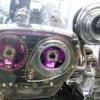R34 3076R Running Temps
Announcements
-
Similar Content
-
Latest Posts
-
By Dose Pipe Sutututu · Posted
If it's for a SR20, make sure it's not the American Poncams, might as well call them Poocams. Had a set in a friend's car, all scuffed up after a few track days. Like the metallurgy Tomei USA used is junk. Went back to JDM OG Tomei Poncams, no issues till now. Tomei USA is not the real OG Tomei. Random rant over, fk the US of A, bunch of c u n t s. -
By TurboTapin · Posted
Most of the industry in North America either runs on Siemens or Allen Bradley. I have two redundant S7-1500's on my desk right next to me for simulation. Siemens has been losing ground though since Stuxnet, as cybersecurity is a big thing. In my line of work that is federally regulated, you must by law have a cybersecurity management program in place and its audited and inspected every so often. I work with Emerson PLC's daily (RX3i's) and have done large biogas/refinery projects with their DCS's. Their PLC's are somewhat OK minus the way they do PLC redundancy (You have to download on both PLC's separately every time you make a change ) As for their DCS's... you'll be limited financially first before anything else stops you. Costs are exorbiant at roughly 10x what it would cost you to do with any other system (e.g AB PAC). 1990's, those suckers are brand new haha! Kraft-Heinz (An old client when I use to work for an ESP) still runs Siemens TI505 PLC's from the mid 80's. Ohh how I don't miss working with those... you could only do a certain number of online downloads until it's "Change" buffer would be full and you would then need to go offline to do a full download. There was no warning of when this was coming up and it generally would happen when you would go in at 2am to make changes before production -_-. -
By TurboTapin · Posted
Unfortunately, not only is that not the case, one of the main "Selling points" of safety over comms is they clearly state in writing that there's no need to segregate safety networks from non-safety networks. It always gets intermingled with everything else on an ICS/OT network. -
By KKaplumbaa · Posted
Hello. I have an a31 cefiro but since I am in Turkey we have a CA20S engine. I did some research. Then I found that I can swap with a ca18 but when I heard that it has the similar substructure as the s13. I thought I can swap with an sr20 because the sr20 was used with the s13. So can I easily swap the sr20 on my cefiro or is it difficult?
-








Recommended Posts
Create an account or sign in to comment
You need to be a member in order to leave a comment
Create an account
Sign up for a new account in our community. It's easy!
Register a new accountSign in
Already have an account? Sign in here.
Sign In Now